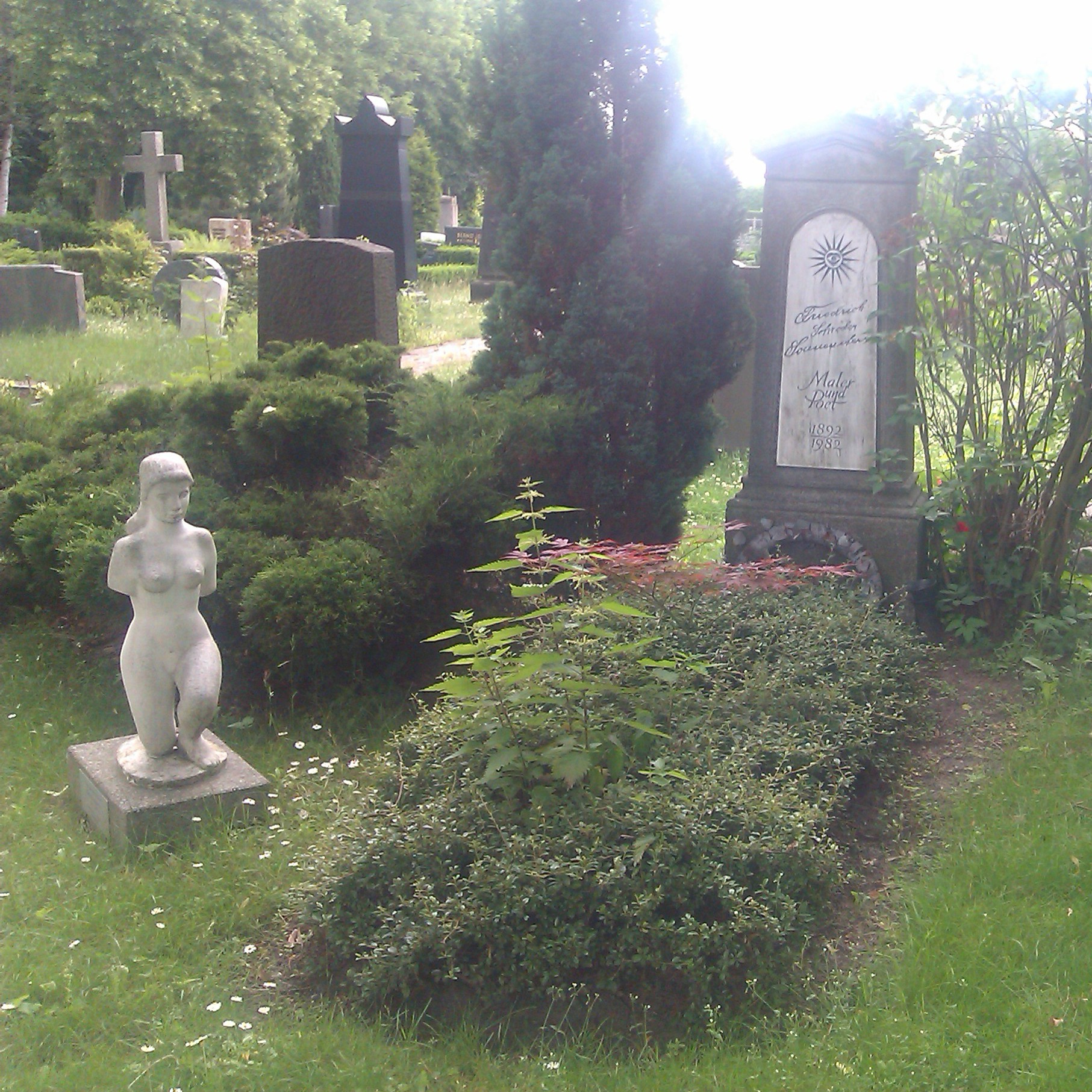- Surname:
- Schröder-Sonnenstern
- First name:
- Friedrich Emil
- Era:
- 20th century
- Field of expertise:
- Fine arts
- Place of birth:
- Kaukehmen (RUS)
- * 11.09.1892
- † 10.05.1982

Schröder-Sonnenstern, Friedrich Emil
German artist, “Berlin character” and psychiatric patient.
Friedrich Schröder-Sonnenstern (1892-1982) was born Friedrich Emil Schröder in Kaukehmen near Tilsit, East Prussia (now Sovetsk, Kaliningrad Oblast, Russia), as the son of a postal employee. The second of thirteen children, he learned early on to assert himself but soon became an outsider. His parents had him sent to a reform school for theft and “vagrancy” when he was 14 years old. In 1912, having abandoned his training in gardening and dairy farming, he developed ideas of grandeur and was diagnosed with “dementia praecox” at the provincial asylum in Allenberg. He briefly participated in WWI in 1915, was rehospitalised in 1918/19 and eventually declared legally incompetent. In 1919, using the name “Gustav Gnass”, he fled to Berlin. He lived in the district of Schöneberg where he preoccupied himself with occultist healing and divination. He founded a religious sect, staged himself as “Sun King Eliot I” and distributed his income to the poor, often in the form of bread rolls, which earned him the title of “Schrippenkönig” (bread roll king). Later in the 1920s, he called himself “Sonnenstern” (sun star), presenting himself as “Professor Eliot Gnas von Sonnenstern”. He was committed to the provincial asylum in Neustadt, Schleswig-Hostein, in 1933.
Becoming an artist
In Neustadt, Schröder met the artist Hans Ralfs, who first encouraged him to draw. Upon his release from the asylum, he spent three years in prison in Kiel and then worked at an air force depot before being detained to a labour camp. In 1942, he fled to Berlin where he managed to hide until the end of WWII. After the war, he started designing painted pamphlets and developed his distinctive style: precise lines and flat colouring, typically using coloured pencil over paint. His works depict bizarre creatures and bear strange titles, such as Mondmoralische Verkehrtheit (World Moral Wrongness) or Schwanenpuppentanz (Swan Puppet Dance). According to Kraft (2005: 210), the tension between “master” and “servant” was the core topic in Schröder-Sonnenstern’s life and his productivity provided protection against mental derailment.
His career as an artist started taking off in the 1950s, he set up his own studio and was celebrated at the 1959 Exposition Internationale du Surréalisme in Paris. He was supported by a number of renowned artists, among them Juro Kubicek, Hans Bellmer and Friedensreich Hundertwasser. Following the death of his long-time companion, Martha Möller, in 1964, he became an alcoholic and homeless. Schröder-Sonnenstern’s work was highly valued until the 1970s, then his reputation on the art market became tainted by scandals over forgery and pieces that were signed by himself but produced by his assistants. In 1969, he was temporarily treated at Karl Bonhoeffer Psychiatric Hospital in Berlin-Wittenau. From 1973 onwards, he was accommodated by one of his former students at her Berlin-Lichterfelde home where he came to rest at last. Friedrich Schröder-Sonnenstern died in 1982 in Berlin at age 89. He is considered one of the internationally most important representatives of “Outsider Art”.
Awards
1967: Retrospective at Kunsthalle Düsseldorf
1973: Retrospective at Kestnergesellschaft in Hanover
1973: Erik Erikson Medal.
Literature
Bader, A. (1972): Geisteskranker oder Künstler. Der Fall Friedrich Schröder-Sonnenstern. Bern: Huber.
Ferentschik, K., P. Gorsen (2013): Friedrich Schröder-Sonnenstern und sein Kosmos. Berlin: Parthas.
Gorsen, P. (1962): Friedrich Schröder-Sonnenstern. Eine Interpretation. Frankfurt on the Main: Von Sydow Zirkwitz.
Gorsen, P. (1997): Friedrich Schröder-Sonnenstern, 1892-1982. Gefallen zwischen Welterlösung und gesellschaftlicher Ausgrenzung. In: I. Brugger, P. Gorsen, K. A. Schröder (eds.): Kunst & Wahn. Vienna: Dumont.
Kraft, H. (2005): Grenzgänger zwischen Kunst und Psychiatrie. Cologne: Deutscher Ärzte Verlag.
Petersen, J. (1972): Die Pferdearschbetrachtung des Friedrich Schröder-Sonnenstern. Munich: Hanser.
Schröder-Sonnenstern, F. (1967): Farbkartons. Exhibition Catalogue, 15. December - 14. January. Düsseldorf: Städtische Kunsthalle.
Schröder-Sonnenstern, F. (1974): Mondgeistfahrt. Munich: Bruckmann.
Schröder-Sonnenstern, F. (1978): Zweiundzwanzig frühe Original-Farb-Zeichnungen. Berlin: Petersen-Galerie.
Schröder-Sonnenstern, F. (1981): Trostlied für Aus- und Angebombte. Vienna: Freibord.
Schröder-Sonnenstern, F., I. Maeder (eds.) (1987): Galerie Maeder. Exhibition. Munich: Hirmer.
Schröder-Sonnenstern, F., J. Petersen (eds.) (2006): Seelenerkennungsdienst. Berlin: Basis.
Robin Pape, Burkhart Brückner
Photo: Ottoerich / Source: Wikimedia / License: CC BY-SA 3.0
Referencing format
Robin Pape, Burkhart Brückner (2015):
Schröder-Sonnenstern, Friedrich Emil.
In: Biographisches Archiv der Psychiatrie.
URL:
biapsy.de/index.php/en/9-biographien-a-z/158-schroeder-sonnenstrern-friedrich-emil-e
(retrieved on:18.06.2025)
